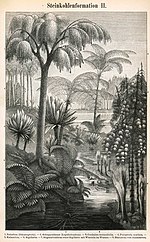part of a united organism, which has inherited the name Calamites in popular culture. Calamites correctly refers only to casts of the stem of Carboniferous/Permian...
9 KB (858 words) - 18:14, 18 October 2024
extinct plants of the genus Calamites in the order Equisetales. Annularia is a form taxon name given to leaves of Calamites. In that species, the leaves...
3 KB (182 words) - 05:11, 24 January 2023
vegetation, with many species of trees, bushes, creepers, etc. Thickets of Calamites seem to have favored the edges of lakes and waterways. Lycopsid genera...
9 KB (956 words) - 21:14, 4 October 2024
Caulopteris were tree ferns. The Equisetales included the common giant form Calamites, with a trunk diameter of 30 to 60 cm (24 in) and a height of up to 20 m...
115 KB (12,084 words) - 18:31, 11 November 2024
of bald cypress, living in mires with waterlogged soils. The tree-like calamites, distant relatives of modern horsetails, lived in coal swamps and grew...
116 KB (11,947 words) - 18:33, 11 November 2024
best known examples of pith casts are in the Carboniferous Sphenophyta (Calamites) and cordaites (Artisia). Authigenic mineralisations. These can provide...
28 KB (2,954 words) - 01:53, 7 August 2024
equisetids were large trees reaching to 30 m (98 ft) tall. The genus Calamites of the family Calamitaceae, for example, is abundant in coal deposits...
41 KB (3,602 words) - 23:25, 18 September 2024
and warm. Extensive swamps developed with mosses, ferns, horsetails and calamites. Air-breathing arthropods evolved and invaded the land where they provided...
161 KB (18,019 words) - 19:28, 2 October 2024
Alethopteris, and Sphenopteris. The Equisetales included the common giant form Calamites, with a trunk diameter of 30 to 60 cm and a height of up to 20 meters...
22 KB (2,737 words) - 12:58, 5 October 2024
Arthropitys. Asterophyllites (or incorrectly Asterophyllum). Astromyelon. Calamites. C. carinatus. C. suckowi. C. undulatus. Calamocarpon. Calamostachys....
3 KB (168 words) - 22:21, 18 December 2023








